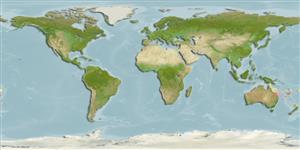Actinopterygii (ray-finned fishes) >
Perciformes (Perch-likes) >
Acanthuridae (Surgeonfishes, tangs, unicornfishes) > Prionurinae
Etymology: Prionurus: Greek, prion, -onos = saw + Greek, oura = tail (Ref. 45335). More on author: Ogilby.
Environment / Climate / Range
Ecology
Marine; brackish; reef-associated; depth range ? - 20 m (Ref. 86942). Subtropical; 20°C - 24°C (Ref. 27115), preferred ?
Southwest Pacific: New South Wales and Lord Howe Island to Queensland; only Capricorn Group and Swains Reefs on the Great Barrier Reef. Also reported from Norfolk, Kermadec, and New Zealand (Ref. 8879).
Size / Weight / Age
Maturity: Lm ? range ? - ? cm
Max length : 45.0 cm TL male/unsexed; (Ref. 2334)
Dorsal
soft rays
(total): 24-26;
Anal
soft rays: 23 - 25. Colour bluish grey with narrow vertical yellow bars on side of body and small yellow spots dorsally on body and on head. Keeled peduncular plates blue and black. Keeled peduncular plates usually 3, no scattered small thorn-like plates dorsally and posteriorly to midlateral series (Ref 9808).
Found along rocky shores, juveniles in estuaries and bays (Ref. 9710). Feeds on benthic algae (Ref. 9710).
Life cycle and mating behavior
Maturity | Reproduction | Spawning | Eggs | Fecundity | Larvae
Randall, J.E., G.R. Allen and R.C. Steene, 1990. Fishes of the Great Barrier Reef and Coral Sea. University of Hawaii Press, Honolulu, Hawaii. 506 p. (Ref. 2334)
IUCN Red List Status (Ref. 115185)
CITES (Ref. 94142)
Not Evaluated
Threat to humans
Harmless
Human uses
Aquarium: commercial
More information
Common namesSynonymsMetabolismPredatorsEcotoxicologyReproductionMaturitySpawningFecundityEggsEgg development
ReferencesAquacultureAquaculture profileStrainsGeneticsAllele frequenciesHeritabilityDiseasesProcessingMass conversion
Tools
Special reports
Download XML
Internet sources
